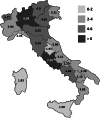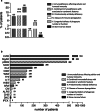The Italian Registry for Primary Immunodeficiencies (Italian Primary Immunodeficiency Network; IPINet): Twenty Years of Experience (1999-2019)
- PMID: 32803625
- PMCID: PMC7505879
- DOI: 10.1007/s10875-020-00844-0
The Italian Registry for Primary Immunodeficiencies (Italian Primary Immunodeficiency Network; IPINet): Twenty Years of Experience (1999-2019)
Abstract
Primary immunodeficiencies (PIDs) are heterogeneous disorders, characterized by variable clinical and immunological features. National PID registries offer useful insights on the epidemiology, diagnosis, and natural history of these disorders. In 1999, the Italian network for primary immunodeficiencies (IPINet) was established. We report on data collected from the IPINet registry after 20 years of activity. A total of 3352 pediatric and adult patients affected with PIDs are registered in the database. In Italy, a regional distribution trend of PID diagnosis was observed. Based on the updated IUIS classification of 2019, PID distribution in Italy showed that predominantly antibody deficiencies account for the majority of cases (63%), followed by combined immunodeficiencies with associated or syndromic features (22.5%). The overall age at diagnosis was younger for male patients. The minimal prevalence of PIDs in Italy resulted in 5.1 per 100.000 habitants. Mortality was similar to other European registries (4.2%). Immunoglobulin replacement treatment was prescribed to less than one third of the patient cohort. Collectively, this is the first comprehensive description of the PID epidemiology in Italy.
Keywords: Primary immunodeficiencies; patient registry.
Conflict of interest statement
The authors declare that they have no conflict of interest.
Figures





References
-
- Tangye SG, Al-Herz W, Bousfiha A, Chatila T, Cunningham-Rundles C, Etzioni A, et al. Human inborn errors of immunity: 2019 update on the classification from the International Union of Immunological Societies Expert Commitee. J Clin Immunol. 2020;40:24–64. doi: 10.1007/s10875-019-00737-x. - DOI - PMC - PubMed
-
- Montserrat A, Taruscio D. Policies and actions to tackle rare diseases at European level. Ann Ist Super Sanita. 2019;55(3):296–304. - PubMed
Publication types
MeSH terms
LinkOut - more resources
Full Text Sources

